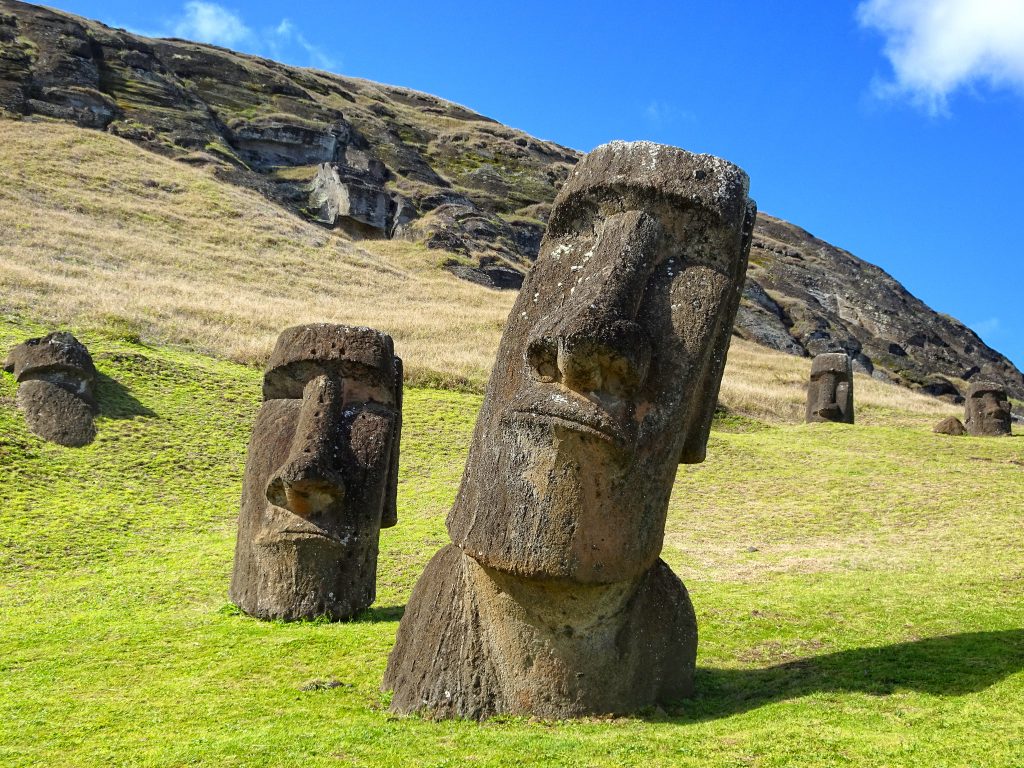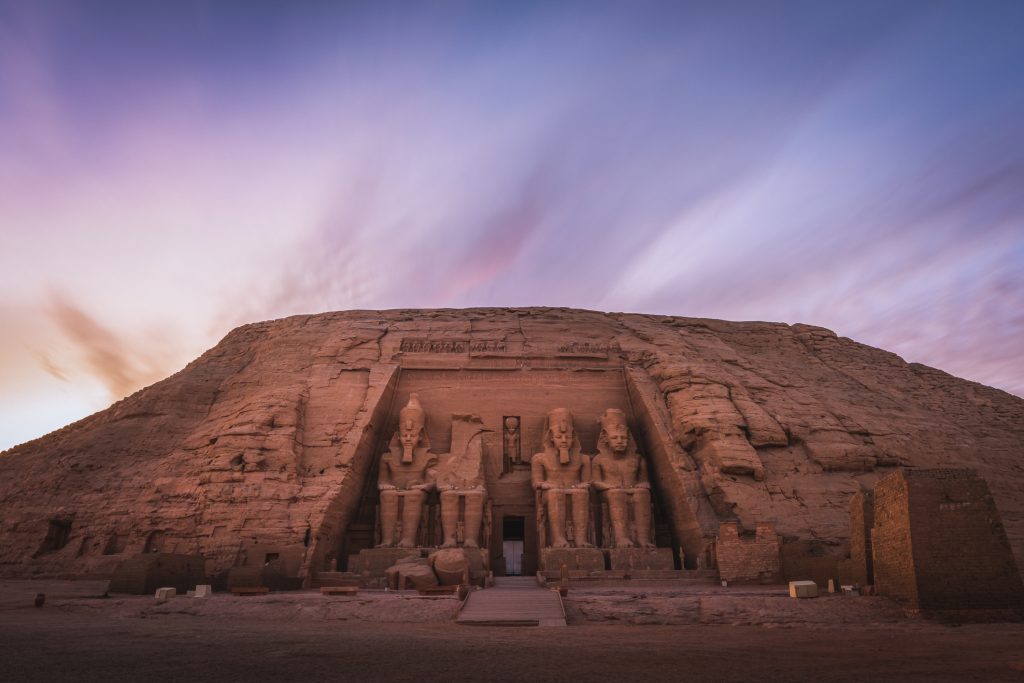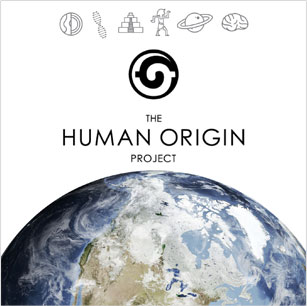Situated on the south-western edge of Cairo, the Egyptian Pyramids are a marvel to behold. They are widely accepted as having been built by the pharaohs of the Old Kingdom over a period of 85 years, between 2589 and 2504 BC.
However, evidence indicates that the Egyptian pyramids could be between 200 and 1,200 years older, while other evidence suggests they may actually be more ancient.
Part I: The Egyptian Pyramids
The three pyramids of the Giza Plateau are named after the three pharaohs who are believed to have ordered them to be built:
- Pyramid of Khufu: the biggest pyramid, also known as the Great Pyramid of Giza.
- Pyramid of Khafre: the second biggest pyramid.
- Pyramid of Menkaure: the smallest of the three, also known as the Lesser Pyramid.
Pyramid of Khufu
Khufu was the second pharaoh of the 4th Dynasty of Egypt’s Old Kingdom. He ruled ancient Egypt for about 24 years, from 2589 to 2566 BC. The Great Pyramid, the largest building of the three, is thought to have been built by around 200,000 to 300,000 workers over a 20 year period that ended about 2560 BC.
For thousands of years it was the tallest building in the world, standing at 146.5 meters, until the Lincoln Cathedral was in England was built in 1311.
Pyramid of Khafre
The middle pyramid is named after the pharaoh Khafre, who was the son of Khufu. Khafre was the third pharaoh of the 4th Dynasty. The length and timeline of his rule over Egypt is disputed, though was possibly sometime between 2558 and 2532 BC.
Although it looks slightly bigger than the Great Pyramid, Khafre is actually smaller but its foundation sits 10 meters higher than the larger pyramid.
Pyramid of Menkaure
The pharaoh Menkaure was the grandson of Khufu and the son of Khafre. He is thought to be the fourth pharaoh of the 4th Dynasty of ancient Egypt, although the records from the Coptic priest Manetho identifies Menkaure as the successor to a pharaoh called Bikheris.
Different sources give different lengths of time for Menkaure’s rulership; Greek historian Heredotus claimed he ruled for just 12 years, Manetho claimed he ruled for 63 years, whereas most Egyptologists believe his reign lasted 18 years.
How Old are the Egyptian Pyramids?
Before the development of modern techniques, Egyptologists originally referred to the King List written by Manetho, who lived sometime in the 3rd century BC. The list details the dates of rulership of Egypt’s first six dynasties, and claims they ruled for a total period of 1,478 years.
However, the King List was passed down and altered over many generations by Christian, Jewish and other scholars, and so its reliability has been questioned. Different versions of the list exist with different dates for the same pharaohs.
Then in 1820, Italian explorer Bernadino Drovetti discovered pieces of a papyrus called the Turin King List, or Turin Canon. This list is about a thousand years older than Manetho’s and claims the first six dynasties ruled for only 955 years.
Although the Turin King List was found in tiny pieces, with more than two thirds of the whole document missing, it is used as the basis for our understanding of ancient Egyptian chronology up until the New Kingdom pharaoh Rameses II.
Some scholars believe the author of the Turin King List was recording an estimated timeline rather, than it being based on fact (for example, there are three reigns in a row each lasting 24 years.)
Was the Great Pyramid of Giza a Tomb?
It is widely regarded as a fact that the pyramids were used as tombs for the pharaohs. However, evidence for this theory is surprisingly small.
The sheer size and shape of the Giza pyramids is anomalous in comparison to the rest of the Egyptian mastabas, which were rectangular ‘pit and mound’ tombs. For hundreds of years, all mastabas before the three Giza pyramids were built in this rectangular format, and all tombs built after the Giza pyramids, such as those found in the Valley of Kings, also used the rectangular design.
There are no inscriptions inside to indicate that the pharaohs had anything to do with the pyramids. Additionally, no remains of pharaohs have been found inside any of the pyramids (only of bodies being buried in them much later, such as a young woman buried in Menkaure around 100 BC.) Khufu had his mother buried in an unmarked grave that wasn’t discovered until 1925, probably so it wasn’t desecrated by grave robbers. Why do this and proceed to have himself buried in what was then the world’s tallest building?
The enormous size of the pyramids would have been likely to attract the attention of potential grave robbers. It was very easy for intruders to enter the pyramid, because a rock covering the entrance apparently just “swivelled open.”
In the Great Pyramid’s Ascending Passageway, it appears that the builders actually put in extra effort to allow intruders to enter the King’s Chamber. A stone counterweight was left there, thought to have been hung from wooden beams to raise the chamber’s stone portcullis easily; giving would-be intruders access to the room where the pharaoh was supposedly buried.
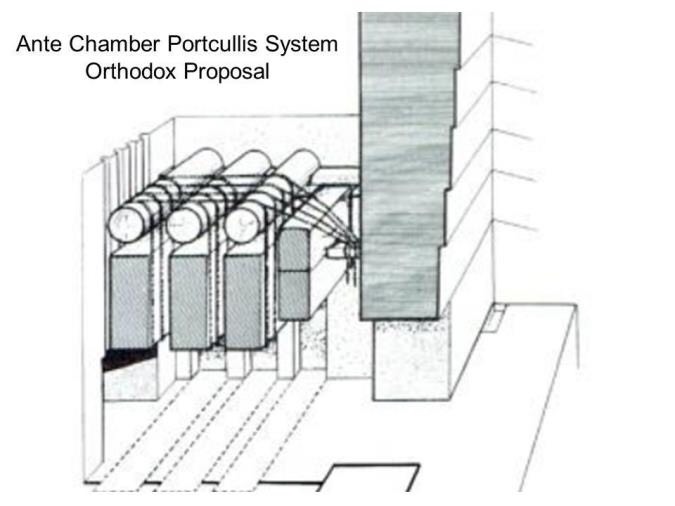
Other Egyptian pyramids have been found with sealed sarcophagi that were empty inside, suggesting that they may not have served as tombs. According to Egyptologist J.P. Lepre:
“The Third Dynasty Pharaoh Huni built a sizable pyramid at Maidum, but it did not contain a sarcophagus. Yet a quite large mastaba located 275 miles to the south at Bet Khallaf did in fact contain a granite sarcophagus, within which were the total skeletal remains of a large man. This mastaba contained the royal name of Huni.”
Does Radiocarbon Dating of the Egyptian Pyramids Agree?
Radiocarbon dating was pioneered in 1949 by Willard F. Libby, a professor from the University of Chicago, who actually invented the technique to examine ancient Egyptian structures. The process measures the presence of carbon-14(C14) in organic material.
All living organisms are made of carbon. C14, an unstable radioactive carbon isotope, has a half life of 5,730 years (meaning it takes 5,730 years for its carbon content to be reduced by half.) When organisms die, C14 begins to disintegrate and because the half life is constant, it can be measured by scientists to determine an approximate date of when that organism was alive.
Libby obtained some wood found in the 3rd Dynasty Step Pyramid, and estimated that its radioactivity should be half that of C14s original carbon level in accordance with the age that the pyramids were thought to be built. (Libby initially measured the half life of C14 as 5,568 years.)
In 1984, and later in 1994 and 1995, prominent Egyptologist Mark Lehner and colleagues did further radiocarbon dating on organic material found at the Old Kingdom monuments, as well as material found at the Giza pyramids, which gave them a variety of dates. Analysing the temples and pyramids that had mud, grass, straw and reeds in their structure was a much easier way to obtain datable samples, whereas the stone pyramids presented a tougher challenge with the scarce availability of organic matter.
| Sample Number | Date (BC) | Stone Layer of the Great Pyramid |
| 10B (charcoal) | 3809 ± 160 | 198th course top platform, SW corner |
| 10B (wood) | 3101 ± 414 | 198th course top platform, SW corner |
| 10A | 3020 ± 131 | 198th course top platform, SW corner |
| 11 | 2950 ± 164 | Top platform, SW corner |
| 08 | 3062 ± 157 | 108-109th course West side, NW corner |
| 07 | 2909 ± 97 | 65th course West side, NW corner |
| 06 | 3090 ± 153 | 25-26th course West side, NW corner |
| 14 | 2998 ± 319 | 5th course South side, SE corner |
| 13 | 2975 ± 168 | 5th course, SE corner |
| 13 | 2864 ± 362 | 5th course SE corner |
| 04 | 2971 ± 120 | 2nd course core block North side |
| 05 | 2929 ± 100 | 2nd course North side, near NW corner |
| 02 | 2909 ± 104 | 2nd course North side East face 2nd tier |
| 01 | 2869 ± 94 | 2nd course North side East end |
| 03 | 2853 ± 104 | 2nd course North face 2nd tier |
Table: Radiocarbon samples obtained by Mark Lehner from the Great Pyramid
There were some discrepancies between the ages of Khufu and Khafre in the 1994 and 1995 analyses, with Khufu, or the Great Pyramid, having a 400 year difference. So, why the big gap between dates?
It is possible that the builders of the Giza pyramids reused material from older structures, accounting for a range of dates spanning hundreds of years. (It should be noted that the accepted dates for the 1stEgyptian Dynasty range from 3600 BC to 2900 BC – a considerable variation of 600 years.)
Problems with Radiocarbon Dating
The main issue with radiocarbon dating is that it is not an exact science, because the estimated level of C14 an organism is always an assumption; it is therefore not entirely reliable.
Furthermore, the C14 level only indicates the age that a biological organism died, not when non-organic materials like stones were assembled. The samples taken from the Giza pyramids were extracted from their exterior surface. Some scholars believe the pyramids were built in stages, in which case carbon dating would only provide evidence of when living organisms died on the outermost layers of the buildings.
Radiocarbon samples taken from the Great Pyramid showed a variation of dates. University of Boston Geologist Robert Schoch has suggested that this wide variety of chronological discrepancies only makes sense if the original Giza pyramids were later renovated. This would explain how later dated samples were found near the top of the pyramid, and it suggests that Khufu and Khafre weren’t the original builders – they just restored the pyramids.
Given the oldest date of 3809 BC, there is a possibility that the Great Pyramid took as long as 248 years to build. Mark Lehner said: “In short, the carbon dates show, depending on which sample you take, that the [conventional] Egyptian chronology is between 200 to 1200 years off.”
Part II: Other Dating Techniques
Finding True North
The Giza pyramids are 99.97% aligned to true north.
To read more about this you can read this article: How the Pyramids of Giza were Built?
Where the sun rises is determined by the spin of the Earth’s axis, which is known as true north. True north and true south are found at the North Pole and the South Pole respectively, forming the axis that Earth rotates on. The Magnetic North Pole is measured by the Earth’s magnetic field, which is located on Ellesmere Island in Northern Canada, (500km from the North Pole.)
The orientation of true north is actually not fixed, but changes as crust shifts occur and physically alter the Earth’s topographical makeup. These alterations of the Earth’s North and South Pole happen very slowly over ages of time. Architects define their orientation by a building’s alignment to true north, or for those in the southern hemisphere, true south.
Engineer Mario Buildreps analysed 910 ancient structures such as pyramids and temples found over the globe. He discovered that all of them have a collective orientation around a central point in Greenland. According to these findings Greenland may have been originally the Earth’s geographical north pole.
Magnetic poles may be displaced when Earth’s crust shifts occur during cataclysmic events.
The Earth’s Shifting Axis
The layout of these ancient monuments in both hemispheres is completely different, and the vast majority of them are all aligned to true north. The chance of this being a coincidence is zero.

Image: The current and former positions of the North Pole and aligning structures throughout the world. Source
The odds of this cluster of structures being built to focus around the same point is 1 to 76 Billion. It also suggests a unified reason behind the building of pyramids found around the world. The shift in the North Pole’s position also explains why Greenland is still covered in ice; because not that long ago (in the Earth’s long existence) it was the coldest part of the world, much like the North and South Poles are today.
According to Buildreps, this indicates that the pyramids are between 4,500 and 26,000 years old, placing them at the time of our current true North Pole’s beginning, before an earth shaking event caused the pole to shift again.
Archeoastronomy of the Egyptian Pyramids
Archeoastronomy is the study by archaeologists of how ancient cultures understood the phenomena of the sky. The relative size and location of the three Giza pyramids are thought to mirror the three stars of the constellation Orion’s Belt, and their size is thought to reflect the varying brightness of each of the stars. To the ancient Egyptians, Orion represented the Osiris, the god of the underworld.
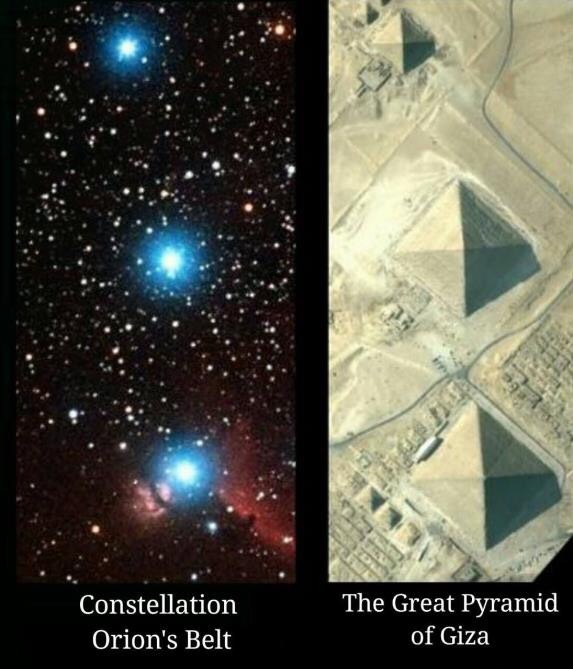
Image: The Giza pyramids appear to be aligned to the constellation of Orion’s Belt. Source
The north and south shafts found in the Queen’s Chamber of the Great Pyramid were discovered to be aligned to Ursa Minor and Sirius respectively. According to engineer and author Robert Bauval, an issue with this alignment is that it would place the building of the pyramids to circa 10,500 BC, when the shafts would have been precisely aligned to Ursa Minor and Sirius. This is known as the Orion Correlation Theory (OCT.)
A statistical analysis of the Orion Correlation Theory was conducted by professor of maths and physics Dr. Vincenzo Orofino and professor of history Dr. Paolo Bernardini. They concluded:
“The simplest version of the OCT… is compatible with what expected for the stars of the Orion Belt on the basis of naked-eye astrometry and photometry, as well as of the stellar evolution theory. Furthermore, it is unlikely that the above cited correlation can be fortuitous. Therefore, there are no astronomical /astrophysical and statistical arguments to reject the hypothesis that the main Giza pyramids would be the monumental reproduction on the ground of the Orion Belt.”
Conclusion
Today new techniques to analyse human history leads to new understanding of the age of ancient monuments. The Pyramids of Giza could be older than first thought.
Examine the evidence and allow yourself to come to your own conclusions. There is still much to learn about the pyramids. You might just discover a piece of the puzzle that brings more clarity to this ancient mystery.
When do you think the Egyptian Pyramids were built?
Further Reading:
https://www.environmentalscience.org/how-radiocarbon-14-dating-works
https://journals.uair.arizona.edu/index.php/radiocarbon/article/viewFile/3874/3299
https://www.academia.edu/7715809/The_Great_Dating_Problem_Part_2_-_Radiocarbon_Dates_and_Early_Egypt
https://docit.tips/download/ten-facts-that-contradict-the-pyramid-tomb-theory-egyptian_pdf
https://gisgeography.com/magnetic-north-vs-geographic-true-pole/
https://ancientegyptonline.co.uk/pyramid-air-shafts/
https://www.researchgate.net/profile/Vincenzo_Orofino



